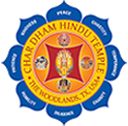Char Dham
The temple is one of the holiest Hindu Char Dham (four divine sites) sites comprising Badrinath, Puri and Dwarka.[12] Though the origins are not clearly known, the Advaita school of Hinduism established by Sankaracharya, who created Hindu monastic institutions across India, attributes the origin of Char Dham to the seer.[13] The four monasteries lie across the four corners of India and their attendant temples are Badrinath Temple at Badrinath in the North, Jagannath Temple at Puri in the East, Dwarakadheesh Temple at Dwarka in the West and Ramanathaswamy Temple at Rameswaram in the South. Though ideologically the temples are divided between the sects of Hinduism, namely Saivism and Vaishnavism, the Char Dham pilgrimage is an all Hindu affair.[14] There are four abodes in Himalayas called Chota Char Dham (Chota meaning small): Badrinath, Kedarnath, Gangotri and Yamunotri – all of these lie at the foot hills of Himalayas.The name Chota was added during the mid of 20th century to differentiate the original Char Dhams.[citation needed] The journey across the four cardinal points in India is considered sacred by Hindus who aspire to visit these temples once in their lifetime.[16] Traditionally the trip starts at the eastern end from Puri, proceeding in clockwise direction in a manner typically followed for circuambulation in Hindu temples.[16]Adi Shankaracharya (Adi Shankara), the eighth century philosopher and reformer who was credited to the revival of Hinduism, was also responsible for coining the words Char Dham, referring to the four holy abodes of the lord Vishnu. During his extensive tour throughout India, he also established Mathas in those four places dedicated to the research and preservation of four Vedas. Jyotir Matha as an example at Badrinath, was assigned the task of maintaining and preserving of Atharv Veda. Sharada Matha at Dwaraka was assigned the task of maintaining and preserving the Sam Veda. Govardhan Matha at Puri was assigned the task of Rig Veda and Sringeri Matha at Sringeri hills in the South India was assigned the task of Yajur Veda. These four pilgrimage places in India are considered to be the most holy places in this universe for Hindus. They are Badrinath, Dwarka, Jagannath Puri, and Rameshwaram. The Char Dham defined by Adi Shankaracharya consists of two Vaishnavite, one Shaivite, and one mixed site. Geographically the Char Dham makes a perfect square with Badrinath and Rameswaram falling on the same longitude and Dwarka and Puri on the same latitude, representing the farthest north, east, west, and south points of India at the time of Adi Shankara. However, there is another Char Dham usually known as “Chhota Char Dham” located in the close proximity of the Himalayas. As opposed to the predominantly Vaishnavite Char Dham coined by Adi Shankara, Chhota Char Dham represents all three major Hindu denominations (Shaktism, Shaivism and Vaishnavism). This Chhota Char Dham includes Yamunotri and Gangotri representing Shaktism, Kedarnath representing Shaivism, and Badrinath representing Vaishnavism. It is a common Hindu belief that Lord Vishnu takes his bath at Rameswaram (in Treta Yug), meditates at Badrinath (in Satya Yug), dines at Puri (in Kali Yug) and retires at Dwarika (in Dwapara Yug).
Badrinath Temple in the north, the abode of Shri Badrinath is also known as BhuVaikuntha, which means earthly abode of Lord Vishnu. Badrinath is located in the Himalayas on the banks of river Alaknanda in the state of Uttrakhand. Dwarka Temple in Gujurat, the abode of Lord Krishna, is also known as Jagat Mandir. There are two main gateways in this temple: the entrance is called Swarga Dwar and the exit is known as Moksha Dwar near the Gomati River. Puri Temple in Odisha is the abode of Lord Jagannath, Balabhadra, Devi Subhadra and Lord Sudarsan. Jagannath means Lord of the Universe. Puri is also famous for its Rath Yatra (car festival) where 3 chariots are pulled in procession carrying Lord Jagannath, his brother Lord Balabhadra and their sister Devi Subhadra. Rameshwaram Temple, the abode of Sri Ramanatha Swamy (Lord Shiva), is located in the South is in the state of Tamil Nadu. It is situated in the Gulf of Mannar at the very tip of the Indian peninsula. This temple is also one of the twelve Jyotirlingas of Lord Shiva in India.
According to Sanatan Dharma, life is divided into four logical stages called Ashramas that include Brahmacharya, Grihastha, Vanaprastha and Sanyasa. The last stage of life is the real preparation for ultimate liberation. Pilgrimage and austerity are the most important characteristics of this phase of life. It is also a general belief that a journey to pilgrim locations will wash away one’s sins and one can attain mokshya. Therefore, Char Dhams are regarded as extremely sacred to all Hindus and pilgrimage to Char Dham at least once in lifetime is a dream come true for all. It is further believed that Adi Shankaracharya purposefully established these four dhams in four corners of India during the 8th century, in an attempt to revive the Hindu religion and unify all Hindus across the country.
Char Dham (literally: ‘the four abodes/seats’) are the names of four pilgrimage places in India that are widely revered by most of the “Hindus”. They are: Badrinath, Dwarka, Jagannath, and Rameshwaram. These temples are in the 4 directions of India (North, West, East & South respectively). The four temples in one place signify unity of people from all around.
The Char Dham defined by the revered saint Adi Shankaracharya consists of two temples from Vaishnavite tradition, one from Shaivite tradition, and one mixed site. The Char Dham are often considered the most revered pilgrimage sites for Hindus that have to be visited in one’s lifetime. The Char Dham Hindu Temple in The Woodlands, TX, will be a unique temple with all the four temples in one location and the only one of its kind in the Unites States and perhaps in the world.
TEMPLE DIETIES
Hinduism
Hinduism is one of the oldest and one of the most popular religions in the world. There are almost 800 million Hindus in India alone and several millions more reside in countries all over the world. In spite of the large number of followers, Hinduism is not well understood by the non-Hindu population of the world. One reason for this is that the existing literature on Hinduism presents a complicated and sometimes apparently inconsistent picture of the religion.
The word Hindu is relatively modern and is derived from the word Sindhu which means red. The Arabs called the Sindhu river the Indus river since they could not pronounce the S-sound. Thus, the people west of the Sindhu river came to be known as the Hindus and the country got its name India. The original name for the country was Bharata Varsha – the land of Bharata, the king who ruled the country in ancient times. The true name of the religion is Sanatana Dharma. Sanatana means ancient and eternal. Dharma means moral duty. The word Sanatana Dharma connotes a Universal Way of Life for all living entities.
Hinduism is unique because it is not founded by a messiah or a guru. Hindus believe that the Creator created both the Universe and the Knowledge about it simultaneously. The seers, called Rishis, obtained this Knowledge of Divine Law directly from God. Another characteristic of Hinduism is that it is not formally organized under any human’s authority. The religious authority has to be earned by one’s own piety and spiritual dedication.
Lord Ganesh
Aum Samukhashchikadantashcha Kapiloo Gajakarnikah
Lambodarashcha Vikaroo Vighnaraja Vinayakah
Dhumraketu Ganaadyaksho Balachandra Gajananaha
Dwadashitaani Naamaani Yah Patheeth Shrunuyadapi
Vidyaarambhe Vivaaheecha Praveeshe Nirgamee Tathaa
Sangraame Nirgamee Chaiva Vighna Tasya Na Jaayate

Lord Ganesh also known as Lord Vinayaka, Vighneshwara, and Gana Pati, is the Agra Ganya (One who is reckoned with first) among gods because He is the remover of obstacles. People pray to Him before starting any project to make it a success by removing all obstacles. He is the son of Lord Shiva and Parvati. His birthday is on the fourth day of the Shukla fortnight of the moon (Shukla Chaviti) in the month of Shravana. The day is called Vinayaka Chaturthi and celebrated all over the world with much joy and many prayers.
He has an elephant’s head which symbolizes wisdom. The trunk is either curved to the right or to the left. Some times it is depicted straight. When the trunk is curved, He is called Vakratunda. He has a large belly, and holds a sweet ball in his hand. His vehicle is the mouse, which symbolizes greed.
There are several forms of Vinayaka – Siddhi Vinayaka etc. He destroys evil spirits when called on as Gam Gana Pataye Namaha. He sets wicked people straight when called upon as Vakratundaya Namaha.
Lord Jagannath Subhadra And Balabhadra
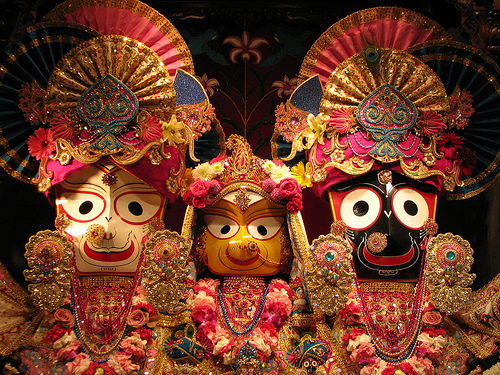
The word Jagannath literally means “Lord of the Universe”. He thus represents the Supreme Being. There are images of Jagannath, his brother Balabhadra and sister Subhadra. These images are made of wood. The original temple dedicated to Lord Jagannath is located in Puri, in the State of Orissa in India, overlooking the Bay of Bengal. The temple in Puri is a hoary pilgrimage center in India consisting of a vast complex occupying an area of over 40,000 square feet. The shikhara of the temple in Puri towers to a height of 192 feet. The temple in Puri took 14 years to build and was consecrated in 1198 CE. Lord Jagannath is believed to be Krishna, Balabhadra is Krishna’s brother Balarama, and Subhadra is Krishna’s sister. The most important festival for Jagannath is the spectacular Chariot festival or Ratha Yatra during the period of June-July every year.
The Jagannath Temple of Puri is a sacred Hindu temple dedicated to Jagannath and located on the eastern coast of India, at Puri in the state of Odisha.The temple is an important pilgrimage destination for many Hindu traditions, particularly worshippers of god Krishna and god Vishnu, and part of the Char Dham pilgrimages that a Hindu is expected to make in one’s lifetime.Even though the icons of most Hindu deities that are worshiped are made out of stone or metal, the image of Jagannath is wooden. Every twelve or nineteen years these wooden figures are ceremoniously replaced by using sacred trees, that have to be carved as an exact replica. The reason behind this ceremonial tradition is the highly secret Navakalevara (‘New Body’ or ‘New Embodiment’) ceremony, an intricate set of rituals that accompany the renewal of the wooden statues.[2]The temple was built in the 12th century atop its ruins by the progenitor of the Eastern Ganga dynasty, King Anantavarman Chodaganga Deva.The temple is famous for its annual Rath Yatra, or chariot festival, in which the three main temple deities are hauled on huge and elaborately decorated temple cars. Since medieval times, it is also associated with intense religious fervour.[The temple is sacred to the Vaishnava traditions and saint Ramananda who was closely associated with the temple. It is also of particular significance to the followers of the Gaudiya Vaishnavism whose founder, Chaitanya Mahaprabhu, was attracted to the deity, Jagannath, and lived in Puri for many years.
MahaLakshmi
Maatar Namaami Kamale Kamalaayataakshi
Sri Vishnu Hrutkamala Vaasini Vishwa Maata
Kshiroodaje Kamala Koomala Garbha Gauri
Lakshmi Praseeda Satatam Namataam Sharanye

Mahaa Deevyicha Vidmahe Vishnu Patneecha Dheemahi Tanno Lakshmee Prachodayaat
Maha Lakshmi is the consort of Lord Maha Vishnu. She was born out of the Ocean of Milk during its churning by the gods and demons in pursuit of the nectar (Amrita). Sri Maha Vishnu took Her to be his consort and placed Her on his chest beside the Kaustubha jewel.
Maha Lakshmi is usually depicted seated in Sukhaaseena on a lotus flower. She has four arms. In two of them, She holds the lotus flowers. The right hand is in Abhaya Mudra. The left hand is Anugraha Mudra pouring out gold. She is the goddess of wealth. She is called Sri by the Vishnavas. Hence Lord Vishnu is called Sridhara, Srinivasa, Srikara, Srivibhavana, Sripati etc. She is also called Rama (pronounced with short Ra) and Ma (hence Maadhava – husband of Ma).
Women all over the world worship Maha Lakshmi for blessings of health, wealth and above all a long and happy marital life. Vara Lakshmi Vratamu and Sumangali Puja are popular among women to worship Maha Lakshmi.
Sudarsana

Sudarshana Chakra is the discus weapon of Lord Vishnu/ Krishna which is usually used for the ultimate destruction of an enemy and protecting good over eveil. Sudarshana Chakra adorns the right rear hand of the four hands of Mahavishnu. This disk-like weapon consists of thousands of sharp edges and produces intolerable heat.
The literal meaning of the Sanskrit word Sudarshana is “auspicious vision”. It is a combination of the words “Su” which means “Divine/auspicious” and “Darshana” which means “Vision”. Sudarshana is worshipped by Vaishnavas and regarded as the Deity who helps the devotees to clear the difficult path to attain the lord.
RadhaKrishna

Radha and Krishna have been a perennial source of inspiration to Indians. Also, Lord Krishna is the most popular god in contemporary Hinduism. He is certainly the best known god outside India because of the Krishna Consciousness movement, and the Bhagvad Gita, one of the best spiritual guides to emerge from India. Krishna is the eighth avatar or reincarnation of the Lord Vishnu, born around 3102 BCE. He spent a happy childhood playing boyish pranks and attracting the gopis (cow girls) and other rustic maidens with his flute playing, which they found irresistible. But his favorite gopi was Radha, his childhood lover. Krishna has become the most popular focus of the devotional and ecstatic aspects of Hindu religion. Devotees of Krishna subscribe to the concept of lila, or divine play as the central principle of the universe.
Dwarakadesh
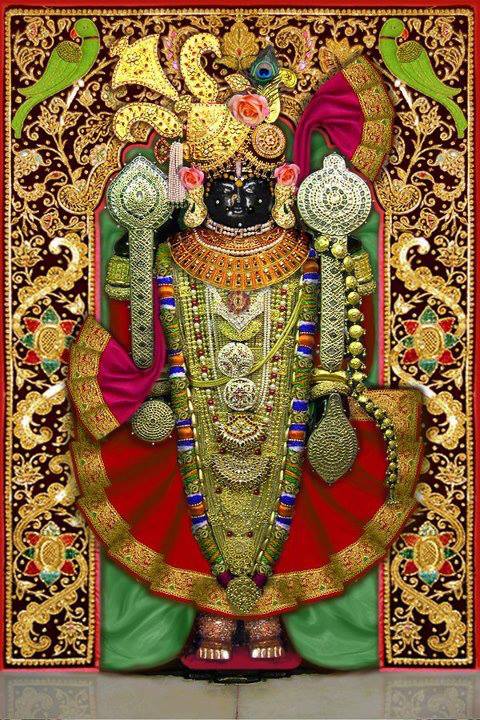
According to Hindu tradition still extant, the earliest known conqueror of Okhamandal was Shri Krishna, called also Ranchodji, the eight incaranation of Vishnu, Who after his seventeenth battle with Jara Sangh, king of Magadh Desh, fled from Mathura, and eventually arrived with his army at Okhamandal which he subjected after a hard struggle with the Kalas. Shri Krishna established his capital at Dwarka on the bank of the Gomti Creek.
Krishna was succeeded by the great grandson of Vajranabh, who enjoys the saintly reputation of having built the present temple Dwarkanath, called also Trilok sundar, signifying ‘the handsomest of the three world’ Many Hindus religiously believe that the temple was erected in one night by supernatural agency, under Vajranabh’s direction.
Certain it is that whole of western and south-western Saurashtra, now included in a Jamnagar and Junaghadh districts was colonized by the Yadavas, whose most important leader was Shri Krishna. The Yadavas ruled and when they perished in a family quarrel under the influence of drink, and after Shri Krishna’s death Dwarka submerged under the sea. In this region the original in habitants are said to Kabas, Modas and Kalas, The Kabas and Modas now seem to be extinct but the present day Vaghers are said to have descended from the Kabas.
The Kalas re-conquered Okhamandal in the 2nd Century A.D next a Syrian Sukkur Belium conquered this region and during this time Dwarka submerged by the sea. He was driven out by another Syrian named Mehem Guduka. Again Kalas now know as Vaghers.
It was 13th century when the Rathods came and took advantage of the Herule-chavada quarrels. The few surviving chavadas and Herules were absorbed by the Vaghers. Veravalji, the Rathod now became the sole ruler of Okhamandal. During the periods of Bhimji, Mahmud Begada who was sultan of Gujarat, conquered Okhamandal destroying the temple at Dwarka. Later the Vaghers drove out the Muslim.
The history of Okhamandal upto 1800 seems to be uneventful but since this date, until their final extermination or submission the Vadhelas and Vaghers came up repetedly against to the British and the Gaikwads.
Lakshmi Narayana

All the Vedic scriptures such as the Four Vedas, the Upanishads, the Gitopanishad, the Srimad Bhagvatam, the Puranas, the Mahabharata, the Ramayana and others in spiritual line recommend that each of us worship Lord Vishnu and His Divine Consort, Laxmi.
Lord Vishnu represents the spiritual aspect of the Supreme Reality, being the protector and maintainer. Vishnu reincarnates on earth from time to time to destroy the evil from the world. His four arms indicate omnipresence and omnipotence. The right side of the body represents the creative activities of the mind and the intellect. The left side symbolizes the activities of the heart; that is love, kindness and compassion.His consort Laxmi is the possessor of wealth, the wealth of grains, courage, valor, offspring, success, luxurious life and eternal and spiritual bliss.
Shirdi Sai Baba
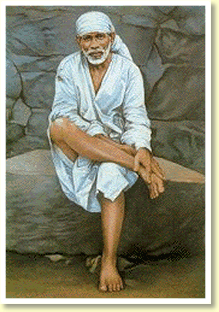
Shirdi Sai Baba, was an Indian spiritual master who was regarded by his devotees as a saint, fakir, and satguru, according to their individual proclivities and beliefs. He was revered by both his Hindu and Muslim devotees, and during, as well as after, his life it remained uncertain if he was a Hindu or a Muslim. This, however, was of no consequence to Sai Baba.[2] He stressed the importance of surrender to the true Satguru or Murshid, who, having trod the path to divine consciousness, will lead the disciple through the jungle of spiritual training.[3] Sai Baba is worshipped by people around the world. He had no love for perishable things and his sole concern was self-realization. He taught a moral code of love, forgiveness, helping others, charity, contentment, inner peace, and devotion to God and guru. He gave no distinction based on religion or caste. Sai Baba’s teaching combined elements of Hinduism and Islam: he gave the Hindu name Dwarakamayi to the mosque in which he lived,[4] practised Muslim rituals, taught using words and figures that drew from both traditions, and was buried in Shirdi. One of his well known epigrams, “Sabka Malik Ek” (“One God governs all”), is associated with Hinduism, Islam and Sufism. He also said, “Trust in me and your prayer shall be answered”. He always uttered “Allah Malik” (“God is King”).
Durga Mata

Sri Durga, as embodiment of Skathi (Strength and Power) is considered to be the supreme Goddess by the Hindus and often referred to as Mother Durga. She is also the embodiment of courage, knowledge, purity, truth, beauty, grace, mercy, and self realization and is multi-dimensional with many names and personas. As Mahishasurmardini, she, with her infinite might, slays the demon Mahishasura. As Parvati, (the Goddess of the mountain) she is serene and extremely beautiful and adores Lord Shiva as his consort in the snowy peaks of Kailash mountain. As Kali, she turns into vibrant darkness, becomes omnipotent, terrible in range and fury and destroys demons, evils and ego. As Ambika, she is the divine mother. As Durga, she protects the mankind from dangers and misfortunes.Sri Durga has several arms. She is depicted as having eight arms holding a different type of weapon in each arm but She is also known to have eighteen arms. She is also depicted in the terrible Kaali form in which She is shown standing on a corpse with out-stretched tongue and unfurled hair. She is the personified Energy of the Lord Naaraayana Himself. Hence She is called Shakti and Her worshippers are called Shaakteeyas.
Badrinarayan
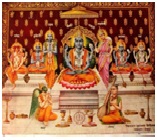
Badrinath Dham In each of the 4 yugas Lord Narayan showed himself to his devotees in various forms. In the Satyayuga, he himself resided in Badrivan and devotees could see Him whenever they wished. Hence this place was also called as Muktiprada. In the Tretayuga, The Lord showed himself only to those devotees who had done great penance. Since devotees gained mukti only through yoga and penance, the place then came to be known as Yogasiddhith. In the Dwaparayuga, this place was frequented by many devotees as its fame spread. Since the Lord gave his vision to a large number of devotees, the place came to be known as BadariVishala. Finally, in this Kaliyuga, the place had an abundance of Badari trees and hence is known as Badarikashram. In Kaliyuga, there was a wide spread development of Buddhism. This religion believed in non-violence but had 2 distinct sects- The Heenyans who were against idol worship and the Mahayaans. In those days, Buddhist pilgrims passed through Badarikashram on route to a pilgrimage to Tibet. Unlike the Heenyaans, the Mahayaans looked upon the Lord’s idol here as another form of Buddha and worshipped him with reverence. The Heenyaans however, soon began to disturb the peace of the Badarikashram. It reached a point when the ascetics who were doing penance there, felt that it may become difficult to protect the Lord’s idols. In the fervent hope that soon, some day, they would be able to rediscover the Lord, they put the idols into the nearby Naradkund. The Lord who had been first installed by Brahma, lay submerged in the cold waters for a long time. When the Buddhist receded, the ascetics, went back to Naradkund to retrieve the Lord’s idols. But to their shock, they couldn’t find Him. Deep in sorrow, they prayed to Lord Shiva. Lord Shiva, assured them that he would be born in this land, to re-establish Vedic traditions and the lost significance of pilgrim centres including Badrikashram. So was born the great preceptor, Sankaracharya at Kerala.At the age of 11, when Sankaracharya came to Badarikashram with his disciples, he felt inspired to spontaneously recite the Ashtapadi. He then began looking for the divine idols along the southern part of the Alaknanda river. As he moved along the left bank, he reached the point of Naradkund and was suddenly certain that the idols must be here. He delved into the chill waters twice, and found 2 idols one after the other. He put them back into the waters since the idols did not have any distinctive features.. The 3rd time also he was about to put the idol back, when a voice said, ” I am Badrinath and have been consecrated by Brahma before. Give me back my rightful place by reinstating Me”. Thus about 2500 years ago, the current idol was consecrated and worshipped by Adi Snakaracharya. He laid out the current practices of the Badrinath temple. Even today, the main priest of the Badrinath temple is a Brahmachari Namboodri from Kerala. As a mark of respect, he is called Ravalji, by the local people.
Saraswati Mata
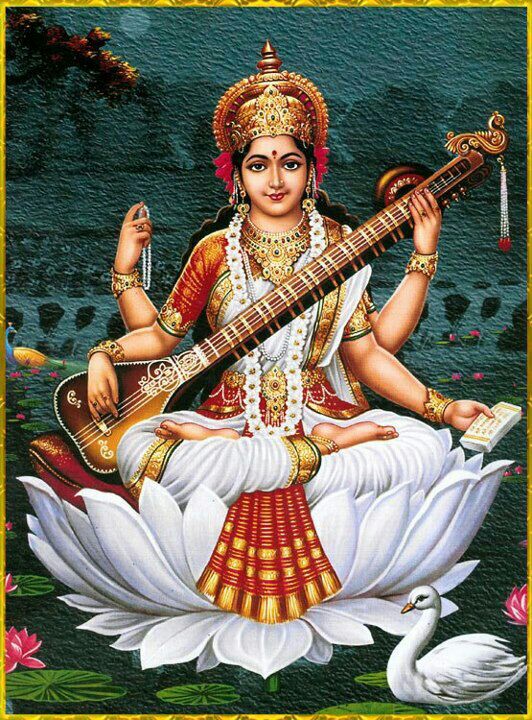
Sarasvati’s female form demonstrates the great respect and recognition that women held in the Vedic tradition. She extols tolerance, as well as moral and spiritual strength. She can withstand roughness and bear pain. She is the consort of Brahma, so this shows that knowledge and creation are in harmony. Her white complexion and garments point to her absolute purity. Her four arms represent the four directions, giving the notion that Sarasvati is all-pervading. The front arms relate to the manifest world, and the back arms to the subjective world. She also demonstrates the four aspects of the personality-the mana, the buddhi, the chitta and the ahankara. The book symbolizes the totality of knowledge. Placing it in the left hand means that acquisition and application of knowledge should be controlled by the softer side of the human personality. The rosary symbolizes concentration or the meditative process involved in the acquisition of knowledge. The swan demonstrates the discriminatory power between right and wrong, as well as the real and unreal. It states,” live in the world, but do not be possessed by it. It symbolizes “jiva” and the “prana” which manifest through the inhaling and exhaling processes. The swan floats above the water in a state of samadhi. The peacock represents mundane knowledge that is unstable and leads to worldly desires. The peacock points to the chance of ignorant activity taking charge of the human personal ity–the dominates the head and the right side. Sarasvati as she is represented in the middle demonstrates a need for for a balance between both. The lotus represents supreme knowledge in activity. It is a symbol of evolution and detachment. It makes its way through the ocean of life by rising above its surface–it is the path from the outer being to the inner being.
The Veena points to the collective sound of all our thoughts and actions as it is manifest as music in the cosmic universe; it marks the withdrawal of the senses and the focus needed to attain knowledge. Placing the left hand on top of the veena closer to the heart shows that knowledge should be used for the good of others. Placing the right hand on the bottom shows that negative knowledge should be kept under control. The veena points to the potential for the negative and positive purposes of knowledge–the choice is left to the person as to which type of knowledge is used.
There is a special type of Veena called Saraswati Veena. The Sarasvati Veena is one of the oldest instruments of the world. It is a fretted organ which can produce notes in four octaves. Four strings are attached to the main bridge and three extra strings are used to keep count of the ‘taala’ or the cycle of beats. The drum to the right is the sound box, the drum to the left is used for support. The goal is to create a melodious, continuous sound or ‘taanam’ which awakens the inner senses. The Veena imparts a vocalized quality, or ‘Gayaki’ which creates the feeling that divinity itself is speaking through the flow of music. The Veena is considered the spinal cord, and the creation of music stirs the invocation of knowledge within the soul.
Vaikhanasa Acharya

Ram Parivar

Rama, Sita, Lakshmana, and Hanuman together constitute the Sita Rama Parivar and each of them represents the noblest of various facets of human character one can aspire for. Lord Rama is the seventh avatar or reincarnation of Lord Vishnu. Lakshmana is his brother and Hunuman is his devotee. To a Hindu, Rama and Sita are the manifestation of a perfect man and a perfect woman. Their adherence to truth under numerous trials and temptations, their steadfast endurance under privations, and their devotion to duty under all vicissitudes of fortune, forms the Hindu ideal of a perfect human life. In this respect the Ramayana (life story of Rama) gives us a true picture of Hindu faith and righteous life. The applicability and relevance of Ramayana as a perennial source of human and moral values is confined not just to India, but to the entire universe.
His mission was to kill the ten-headed demon Raavana and to rid the Dandaka forest, south of the Vindhya Mountains, of the demons. Many sages were living in this dense forest to carry on their Yajnas and prayers to gods but the demons would harass them and disturb their peace. Upon requested by His father, Raama willingly exiled Himself to the Dandaka forest and killed all the demons in the forest. Raama is also known for His upholding of Law and Order. The demon Raavana himself was killed by Raama in his own country Lanka, the modern Ceylone. The story of Raama is narrated in the epic Raamaayana by Vaalmiki which is translated in to every language of India.
Ramanataha Swamy

The temple and the island of Rameswaram have acquired this name because, Lord Rama worshipped Lord Shiva, the God of Gods here on return from Sri Lanka. According to legend, after killing Ravana Lord Rama returned with his consort Goddess Seetha to India first stepping on the shores of Rameswaram. To expiate the “dosha” of killing a brahmin, Lord Rama wanted to offer worship to Lord Shiva. Since there was no shrine in the island had despatched Sri Hauman to Kailash to bring an idol of Lord Shiva.
Rameswara means “Lord of Rama” in Sanskrit, an epithet of Shiva, the presiding deity of the Ramanathaswamy Temple.[5] According to Hindu epic Ramayana, Rama, the seventh avatar of the god Vishnu, prayed to Shiva here to absolve any sins that he might have committed during his war against the demon-king Ravana in Sri Lanka.[6][3] According to the Puranas (Hindu scriptures), upon the advice of sages, Rama along with his wife Sita and his brother Lakshmana, installed and worshipped the lingam (an iconic symbol of Shiva) here to expiate the sin of Brahmahatya incurred while killing of the Brahmin Ravana.To worship Shiva, Rama wanted to have the largest lingam and directed his monkey lieutenant Hanuman to bring it from Himalayas. Since it took longer to bring the lingam, Sita built a small lingam, which is believed to be the one in the sanctum of the temple.This account is not supported by the original Ramayana authored by Valmiki,[9] nor in the Tamil version of the Ramayana authored by Tamil poet, Kambar (1180–1250 CE). Support for this account is found in some of the later versions of the Ramayana, such as the one penned by Tulasidas (15th century).]Sethu Karai is a place 22 km before the island of Rameswaram from where Rama is believed to have built a floating stone bridge, the Ramsetu bridge, that further continued to Dhanushkodi in Rameswaram till Talaimannar in Sri Lanka.[6][12] According to another version, as quoted in Adhyatma Ramayana, Rama installed the lingam before the construction of the bridge to Lanka.
Sri Venkataswara(Balaji)

Shri Venkateeshwara of Tirupati has the reputation of being “the visible Lord who replies to any one who calls on Him (Pilichina palikee pratyaksha Divam)”. He is the Lord of the Seven Hills in the city of Tirupati in Andhra Pradesh. The story of Sri Venkateeshwara is narrated in the Padma Purana. According to this Purana, Sri Venkateeshwara is the incarnation of Lord Vishnu in Kali Yuga. His consort Alimelu Manga is none other than the goddess Maha Lakshmi.
History tells us that the temple of the Lord Venkateeshwara was built some 500 years ago Legend has it that a sage discovered the Lord’s image under an anthill on top of the Seven Hills and built a temple for the Lord. The temple was well supported by kings of several dynasties that ruled the South India. A lot is known about this temple from the writings about the money, land and gold that the kings gave to the temple.
Today, the temple is perhaps the richest in the world. Several thousand pilgrims lineup to visit the Lord everyday and offer Him anything and everything of value in their possession, including their hair. Even ladies shave their hair in gratitude of what they have received from the Lord.
Ayyappa Swamy

Lord Ayyappan or simply Ayyappa (also spelled as Ayappa) is a popular Hindu deity worshiped mainly in South India. Ayyaappa is believed to be born out of the union between Lord Shiva and the mythical enchantress Mohini, who is regarded as an avatar of Lord Vishnu. Therefore, Ayyappa is also known as ‘Hariharan Puthiran’ or ‘Hariharputhra,’ which literally means the son of both ‘Hari’ or Vishnu and ‘Haran’ or Shiva.
Ayyappa is also commonly known as ‘Manikandan’ because, according to the legend of his birth, his divine parents tied a golden bell (mani) around his neck (kandan) soon after his birth. As the legend goes, when Shiva and Mohini abandoned the baby on the banks of the Pampa river, King Rajashekhara, the childless monarch of Pandalam, found the newborn Ayyappa and accepted him as a divine gift and adopted him as his own son
Sri Ayyappa is Hari -Hara Putra, the Son of Hari (Vishnu) and Hara (Shiva). The legend of Ayyappa is as follows. After the gods and demons obtained the nectar by churning the Ocean of Milk, they started quarrelling about it. So Sri Maha Vishnu took on the form of a beautiful maiden, Mohini, and offered to divide the nectar among them. By her bewitching ways, Mohini made the demons forget about nectar while the gods consumed all of it. Thus the Lord prevented the demons from acquiring immortality.
Later, Shiva came to know this and He could not believe it. To remove His doubts, Sri Maha Vishnu once again took the form of Mohini to show Shiva her beauty. Shiva immediately fell in love with Mohini and as a result of their union, Ayyappa was born.
The devotees also observe a special forty-day period every year during which they perform Bhajans and commit themselves to good spiritual behavior.
Navagraha

In Hindu religion and mythology, the Navagrahas occupy an important role. Nava means nine. Graha means planet. Graha literally means to grab. They are probably called so because they cause eclipses by grabbing the Sun and other stars. The nine planets are:
Ravi (The Sun)Soma (The Moon)Kuja or MangalaBudha (Jupitor)Brihaspati or GuruShukraShani (Saturn)RahuKetu
Each of the planets is supposed to bestow a particular boon to humans. The Hindu astrology is based on an elaborate calculation of the positions of these planets at the time of one’s birth. For example, the zodiac is divided in to twelve zones (‘houses’ of 30 degrees each). The planet Sun travels in to one of these houses each month. Similarly, the other planets have their times of travel through the zodiac assigned to them. As the planets travel through these zodiac signs, their relative positions with respect to each other changes and is supposed to determine the fate of the human affairs. An astrologer can draw up a horoscope of a person based on his time of birth and calculate the relative positions of the planets relative to this horoscope. The planets are also believed to influence the outcomes of historical events of entire nations and the Earth. Each planet has its own mode of circumambulation – clockwise or anti-clockwise. Each planet faces a different direction. In religious rites, the planets are represented by beetle nuts and the priest invites each planet to be present there and witness and bless the puja.
Panchamukha Hanuman
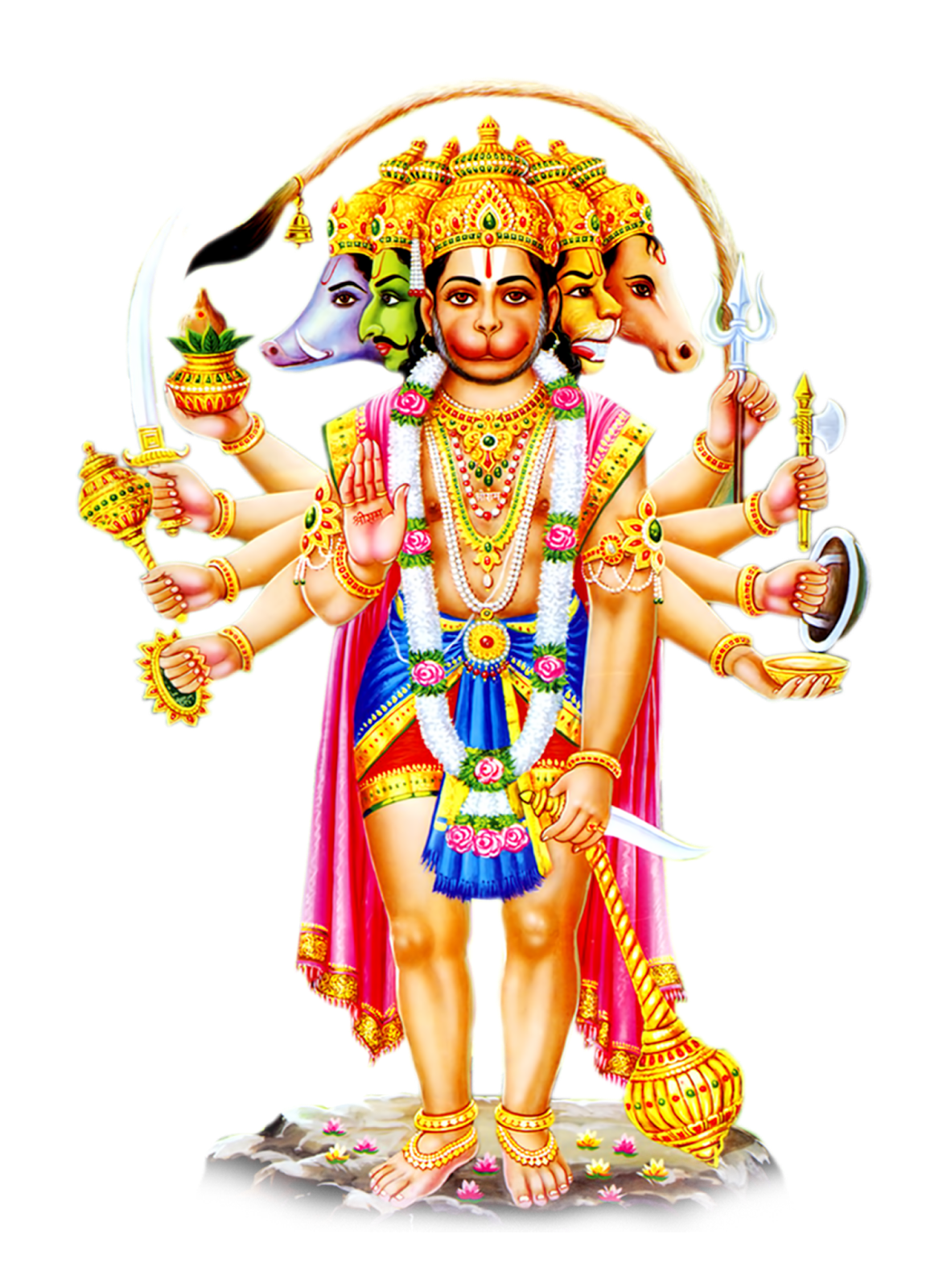
Shri Panchmukhi Hanuman is the form of Lord Hanuman with five faces. The Panchmukhi Hanuman is the virata roopa of Lord Hanuman, a gigantic form of Lord Hanuman.There are two forms of Panchmukhi Hanuman. In the first form, all the five heads of Panchmukhi Hanuman are that of Hanuman and in another form, all the five heads are that of Hayagriva, Narasimha, Hanuman, Varaha and Garuda. Out of these, Hayagriva, Narasimha and Varaha are incarnations of Lord Vishnu. Hence, Panchmukhi Hanuman is also known as the combined avatar of Lord Vishnu and Lord Hanuman. Shri Panchmukhi Hanuman is believed to be Tantric representation of Lord Hanuman.
The meaning of Five Faces of Lord Hanuman are:
1. East facing Anjaneya to grant humanity Ishta Siddhi.
2. South facing Karala Ugraveera Narasimha to grant humanity Abhista Siddhi.
3. West facing Mahaveera Garuda to grant humanity Sakala Sowbhagya.
4. North facing Lakshmi Varaha to grant humanity Dhana Prapthi.
5. Urdhva Mukha {atop} being Hayagriva to grant humanity Sarva Vidya Jaya Prapthi.
According to the story in Ramayana, during the war, Ravana took help of Mahiravana to win the battle. Mahiravana was the king of Patala Lok, under-world. Mahiravana kidnapped Lord Ram and Lakshman and took them to Patala Lok. Lord Hanuman rushed to protect Lord Ram and Lakshman and entered Patala Loka.Lord Hanuman fought a fierce battle with Mahiravan but was not able to defeat him. Lord Hanuman found out that to kill Mahiravana, he had to extinguish five lamps in five different directions simultaneously. The life of Mahiravana was in 3 lamps representing direction. To extinguish the five lamps burning in five different directions at the same time, Lord Hanuamn took the form of Panchmukhi Hanuman – Hanuman, Hayagriva, Narasimha, Garuda and Varaha faces. Shri Panchmukhi Hanuman extinguished the five lamps and killed Mahiravana.

